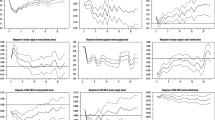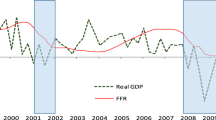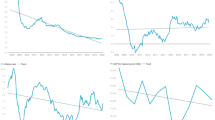Abstract
This paper examines the dynamic linkages between the federal funds rate and the stock market during the 1970–2004 period using the VAR methodology. We detected a disconnection between Fed actions and market responses in the 1990s relative to the 1970s and 1980s. Upon further analyses, we observed asymmetric effects of monetary policy actions on the stock market and that such actions were more turbulent during bear markets than bull markets. Overall, our results appear to suggest that there was consistent dynamic relationship between the conduct of monetary policy and the corresponding behavior by the stock market during the last three decades.







Similar content being viewed by others
References
Bernanke BS, Blinder AS (1992) The federal funds rate and the channels of monetary transmission. Am Econ Rev 82:901–921
Bernanke B, Gertler M (1999) “Monetary policy and asset price volatility.” In: New challenges for monetary policy. Federal Reserve Bank of Kansas City
Bernanke B, Kuttner K (2005) What explains the stock market’s behavior to monetary policy? J Finance 3:1221–1257
Bordo M, Jeanne O (2001) “Asset prices, reversals, economic instability and monetary policy.” Paper presented at the allied social sciences association meeting in New Orleans, Louisiana
Bordo MD, Wheelock DC (2004) Monetary policy and asset prices: a look back at past US stock market booms. Federal Reserve Bank of St. Louis Rev 86(6):19–44
Bordo MD, Dueker MJ, Wheelock DC (2007) “Monetary policy and stock market booms and busts in the 20th century.” Paper prepared for second economic history panel: past, present and policy, CERP and Institute d’ Etudes Politiques de Paris, 2006
Campbell JY, Ammer J (1993) What moves the stock and bond markets? A variance decomposition for long-term asset returns. J Finance 48:3–26
Campbell JY, Shiller R (1988a) Stock prices, earnings, and expected dividends. J Finance 43:661–676
Campbell JY, Shiller R (1988b) The dividend price ratio and expectations of future dividends and discount factors. Rev Financial Stud 1:195–228
Cecchetti S (2003a) “Inflation targeting, price-pat targeting and output variability.” National Bureau of economic research working paper no. 9672
Cecchetti S (2003b) “Should central banks respond to asset price movements? Theory and evidence.” Paper presented at ECB workshop on asset prices and monetary policy
Christiano LJ, Eichenbaum M (1991) “Identification and the liquidity effect of a monetary policy shock.” Working Paper No. 3920, National Bureau of economic research
Christiano LJ, Eichenbaum M, Evans CL (1996a) The effects of monetary policy shocks: evidence from the flow of funds. Rev Econ Stat 78(1):16–34
Christiano LJ, Eichenbaum M, Evans CL (1996b) Identification and the effects of monetary policy shocks. In: Blejer M, Eckstein Z, Hercowitz Z, Leiderman L (eds) Financial Factors in Economic Stabilization and Growth. Cambridge University Press, Cambridge, pp 36–74
Christiano LJ, Eichenbaum M, Evans CL (1999) “Monetary policy shocks: what have we learned and to what end?” In: JB Taylor, M Woodford (eds.) Handbook of macroeconomics, vol. IA, chap 2. Amsterdam, North Holland, pp. 65–148
Clarida R, Gali J, Gertler M (2000) Monetary Policy Rules and Macroeconomic Stability: Evidence and Some Theory. Q J Econ 115(1):147–180
Craine R, Martin V (2004) “Monetary policy shocks and security market responses.” Working Paper, University of California at Berkeley
Cuñado J, Gil-Alana LA, Perez De Gracia F (2009) US Stock Market Volatility Persistence: Evidence Before and After the Burst of IT Bubble. Rev Quant Financ Acc 33:233–252
DeGrauwe P (2008) “Stock prices and monetary policy.” CEPS Working Document No. 304, Centre for European policy studies
Detken C, Smets F (2003) “Asset price booms and monetary policy.” Paper presented at ECB workshop on asset prices and monetary policy
Dickey DA, Fuller WA (1987) Distribution of the Estimators for Autoregressive Time Series with a Unit Root. J Am Stat Assoc 74:427–431
Ehrmann M, Fratzscher M (2004) Taking Stock: Monetary Policy Transmission to Equity Markets. J Money, Credit Banking 36(4):719–737
Fuhrer J, Tootell G (2004) “Eye of the prize: how did the fed respond to the stock market?” Manuscript, Federal Reserve Bank of Boston
Goodfriend M (2002) The phases of US monetary policy: 1987 to 2001. Economic Quarterly, Federal Reserve Bank of Richmond, Fall 88/4:1–17
Guo H (2004) Stock Prices, Firm Size, and Changes in the Federal Funds Rate. Quart Rev Econ Finance 44:487–507
Hamburger MJ, Kochin LA (1972) Money and Stock Prices: The Channels of Influence. J Finance 27:231–249
Hayford JD, Malliaris AG (2004) Monetary Policy and the US Stock Market. Econ Inq 42(3):145–169
He LT (2006) Variations in effects of monetary policy on stock market returns in the past four decades. Rev Financial Econ 15(4):331–349
Helbling T, Terrones M (2004) “When bubbles burst”, World Economic Outlook, April, IMF, 61–94
Homa KE, Jaffee DM (1971) The supply of money and common stock prices. J Finance 26:1056–1066
Johansen S (1995) Likelihood-based Inference in Co-integrated Vector Autoregressive Models. Oxford University Press, Oxford
Lee BS (2003) Asset returns and inflation in response to supply, monetary, and fiscal disturbances. Rev Quant Financ Acc 21(3):207–231
Lobo BJ (2000) Asymmetric effects of interest rate changes on stock prices. Financial Rev 35(3):125–144
Lobo BJ (2002) Interest rate surprises and stock prices. Financial Rev 37(1):73–92
Normandin M, Phaneuf L (2004) Monetary policy shocks: testing identification condition under time-varying conditional volatility. J Monet Econ 51:1217–1243
Patelis AD (1997) Stock return predictability: the role of monetary policy. J Finance 52:1951–1972
Ravn MO, Sola M (2004) Asymmetric effects of monetary policy in the United States. Federal Reserve Bank of St. Louis Rev 86(5):41–60
Rigobon R (2003) Identification through Heteroskedasticity. Review Econ Stat 85(4):777–792
Rigobon R, Sack B (2001) “Measuring the reaction of monetary policy to the stock market.” NBER Working Paper no. 8350
Rigobon R, Sack B (2003) “The impact of monetary policy on asset prices.” Working Paper
Rogalski RJ, Vinso JD (1977) Stock returns, money supply and the direction of causality. J Finance 32(4):1017–1030
Roley VV, Sellon GH (1998) “The response of the term structure of interest rates to federal funds rate target changes.” Mimeo, Federal Reserve Bank of Kansas City
Sims CA (1980) Macroeconomics and Reality. Econometrica 48:1–48
Sims CA (1992) Interpreting the Macroeconomic Time-series Facts: the Effects of Monetary Policy. Eur Econ Rev 36:975–1000
Smirlock M, Yawitz J (1985) Asset returns, discount rate changes, and market efficiency. J Finance 40:1141–1158
Thorbecke W (1997) On stock market returns and monetary policy. J Finance 52:635–654
White EN (2004) “Bubbles and busts: the 1990s in the mirror of the 1920s.” Paper presented at Duke University and the University of North Carolina conference, understanding the 1990s: The Long-Run Perspective, Durham, North Carolina
Acknowledgments
The author is indebted to an anonymous reviewer who made several insightful comments and the Review’s editor, C. F. Lee, for encouragement. An earlier draft of this paper was presented at the Eastern Economic Association (2007) meetings and the comments by Phillip Arestis and the session participants are gratefully acknowledged. Finally, this paper benefited from a grant from Fairfield University. The usual disclaimer applies
Author information
Authors and Affiliations
Corresponding author
Rights and permissions
About this article
Cite this article
Laopodis, N.T. Dynamic linkages between monetary policy and the stock market. Rev Quant Finan Acc 35, 271–293 (2010). https://doi.org/10.1007/s11156-009-0154-7
Published:
Issue Date:
DOI: https://doi.org/10.1007/s11156-009-0154-7




